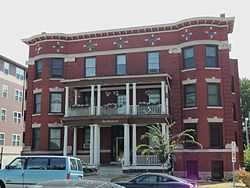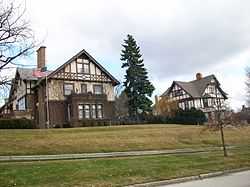McClellan Heights Historic District
The McClellan Heights Historic District is a 188.2-acre (76.2 ha) historic district in Davenport, Iowa, United States. It was listed on the National Register of Historic Places in 1984, at which time it included 354 buildings deemed to contribute to the historic character of the area.[1] The area was known as Camp McClellan during the American Civil War, and gives the neighborhood its name. It was the largest of the five Union Army training camps in and around the city of Davenport.[2]
Description
McClellan Heights is the largest neighborhood in the east end of Davenport. It is located east of the Village of East Davenport. It runs from Jersey Ridge Road to the Bettendorf city limits, and from River Drive to Middle Road. Four hundred houses make up the McClellan Heights neighborhood, dating from 1905-1940.[3] The neighborhood is made up of many hills and ravines. The streets follow the topography which requires many winding roads and odd-shaped lots. The southern portion of McClellan Heights is very wooded which adds to the attractiveness of the neighborhood.[4] Developed from south to north, four very large mansions before World War I became popular for upper-middle class residents. The neighborhood was mostly settled by Dutch and New England immigrants. The park-like setting, and proximity and view of the river, have kept this neighborhood fashionable even today. The houses remain in good to excellent condition. The few brick streets that run through the neighborhood remain in excellent condition.
Architecture
Housing styles in McClellan Heights tend to follow a free-form eclecticism that was characteristic of the period rather than a desire to recreate classical architectural styles.[3] Elements of past styles were utilized here, but they were employed in a less literal fashion by using a few details to suggest rather than recreate the earlier forms. The revival styles that were more commonly used in the neighborhood were Tudor Revival and Mediterranean Revival as well as the Colonial Revival forms from New England to Dutch and Georgian. The Prairie style is somewhat ubiquitous throughout the neighborhood, but again, not in a literal sense. There are are only a few textbook examples of the style in McClellan Heights. Instead, it found its expression in the use of broad roofs, horizontal window openings, and placing upper story windows just below the eaves. Its use was adapted by combining the Prairie style with the revival styles as well as two other typically American styles that were found in throughout the neighborhood, American Craftsman and American Foursquare.
Contributing properties
References
- ↑ 1.0 1.1 "National Register Information System". National Register of Historic Places. National Park Service. 2009-03-13.
- ↑ Svendsen, Marls A., Bowers, Martha H (1982). Davenport where the Mississippi runs west: A Survey of Davenport History & Architecture. Davenport, Iowa: City of Davenport. p. 16-1.
- ↑ 3.0 3.1 Dennett, Muessig & Associates, Ltd. "McClellan Heights Historic District" (PDF). Davenport Community Development Department - Iowa Division of Historic Preservation. Retrieved 2014-04-15.
- ↑ Plan and Zoning Commission (December 1985). Historic Preservation in Davenport, Iowa.
|
|---|
| | City and Government | |
|---|
| | Landmarks | |
|---|
| | Education | |
|---|
| | Transportation | |
|---|
| | Neighborhoods | |
|---|
| | Parks | |
|---|
| | Other | |
|---|
|
|
|---|
| | Topics | |
|---|
| | Lists by states | |
|---|
| | Lists by insular areas | |
|---|
| | Lists by associated states | |
|---|
| | Other areas | |
|---|
|
-
 Category Category
-
 Portal Portal
-
 WikiProject WikiProject
|
|
|
|---|
| | Houses A-B-C | | |
|---|
| | Houses D-E-F | |
|---|
| | Houses G-H-I | |
|---|
| | Houses J-K-L | |
|---|
| | Houses M-N | |
|---|
| | Houses O-P-Q | |
|---|
| | Houses R-S-T | |
|---|
| | Houses U-V-W | |
|---|
| | Apartment Buildings | |
|---|
| | Residential Historic Districts | |
|---|
|
.svg.png)



